Hudson River Almanac 2/16/19 - 2/22/19
The New York State Department of Environmental Conservation sent this bulletin on 03/01/2019 02:00 PM EST |
| DEC Delivers - Information to keep you connected and informed from the NYS Department of Environmental Conservation |
| Share or view as a web page || Update preferences or unsubscribe |
Hudson River Almanac
|
Compiled by Tom Lake, Hudson River Estuary Program Consulting NaturalistOverviewThere was an indication this week that at least some of our Hudson River Valley bald eagles were on eggs. Given the anticipated length of incubation, that would suggest hatches occurring in late March. As a reminder of winter, we had an uncommon-to-rare visit from a boreal songbird, the pine grosbeak. As a promise of springtime, we had our first significant arrival of male red-winged blackbirds. Highlight of the Week
[Pine grosbeaks are a big, boreal (northern) finch, nearly robin-size, uncommon but widespread in spruce and fir forests of the north where they breed in open coniferous forests. The female is mostly gray with a yellowish crown and nape, dark wings, with two wing bars, and a dark tail. Males are a dull rose-red. John Kent estimates that pine grosbeaks show up maybe one winter in ten. They are irruptive, moving around in large flocks in the winter to find food. In years when seed and fruit crops are poor throughout much of eastern Canada, they will move as far south as they have to in search of food. They are often found in crabapple trees. Alan Mapes has been at Five Rivers Environmental Education Center in Delmar for 30 years, and it has been that long, or longer, since the last time he saw a pine grosbeak in the center’s crabapple trees. Tom Lake] Natural History Entries2/16 – Fort Edward, HRM 202: We took a three-hour midday survey of the Fort Edward Grasslands in Washington County. We totaled 16 bird species. Highlights included 45 horned larks, one snow bunting, five rough-legged hawks, and four northern harriers.
2/16 – Town of LaGrange, HRM 69: On 2/11, when we noted the presence of 12 redheads in two ponds in LaGrange, the number expressed was a typo. There were five redheads. These beautiful ducks breed near the Great Lakes and points north and west. In the past, their population was declining, but management efforts have successfully stabilized their numbers. However, being an uncommon winter visitor, precision in reporting their numbers is important.
2/17 – Albany, HRM 145: In late afternoon, I spotted a red-throated loon on the Hudson River near Corning Park. [There are no previous February records of red-throated loon in this part of New York, so this was a very good find. John Kent (Hudson-Mohawk Bird Club] 2/17 – Rockland County, HRM 33: I had high hopes this year for bald eagle nest NY336. In early evening, I spotted one adult on the nest and another perched nearby. Twenty minutes later, the two adults switched places. This was certainly suggestive of incubating eggs. 2/18 – Copake Falls, HRM 106: As we searched for birds along Valley View Road and Taconic State Park, we noticed a group of American robins, one of which had white plumage (leucistic). [Leucism is an abnormal plumage condition caused by a genetic mutation that prevents pigment, particularly melanin, from being properly deposited on a bird’s feathers. As a result, the birds do not have the normal, classic plumage colors listed in field guides. Leucism affects only the bird’s feathers, and typically only those with melanin pigment - usually dark feathers. Birding.about.com] 2/18 – East Fishkill, HRM 66: Two dozen male red-winged blackbirds descended on my yard this morning. This may be the earliest date I have ever seen them here. 2/18 – Manitou, HRM 46.5: While we have had a small contingent of male red-winged blackbirds as daily visitors to our feeders all winter, just before sunset today, a flock of 80 red-winged blackbirds and brown-headed cowbirds, with a few females of each, dropped in for a quick feed before dark. For a minute, it appeared to be raining black birds. 2/19 – Albany, HRM 145: The red-throated loon that was reported by Craig Driggs two days ago was still on the Hudson River this morning sitting on the water off Corning Riverfront Park. Tristan Lowery found it first, and I went out to join him. It took flight and headed upriver landing near the Livingston Avenue railroad bridge. When the light hit it at a certain angle, we could see a hint of red in its throat, apparently the beginning of its molt into breeding plumage. 2/19 – Town of Copake, HRM 108: I was able to locate the previously reported Townsend’s solitaire on High Valley Road in Taconic State Park today. Almost as exciting were the fresh bobcat tracks in the snow. *** Fish of the Week ***
The summer sucker was formerly included with the white sucker (C. commersoni), a common species in the watershed. However, analyses done by Morse and Daniels in 2009 (Copea 2009: 214-220), elevated the summer sucker to full species status. The paper cited a 1934 record from Little Pine Lake, Hamilton County, in the Mohawk River drainage, thus the Hudson River watershed. Karin Limburg notes that the summer sucker is a good example of allopatric speciation. This occurs when a population becomes sufficiently isolated from its parent population (white sucker) to allow unique mutations and adaptations to occur to make it significantly different enough to warrant being a new species. (Photo of summer sucker courtesy of Doug Carlson) Tom Lake] 2/20 – Warren County, HRM 245: I drove along the Hudson River this morning south of The Glen and past the Ice Meadows. The glacial river-scape we see during some Arctic-like winters was not in evidence this year. All this winter had to show was three feet of frazil ice with an occasional open channel winding through. In some years, the river channel carves through fifteen-foot-high canyons of ice. On those occasions, you can walk across the river as though traversing a glacier.
2/20 – Esopus Meadows, HRM 87: There had been enormous ice melt in the river this week at Norrie Point. A week ago, ice spanned from the east-side cove to Esopus Island. But now there were only a few flotillas of ice chunks adrift in largely open water. A raft of 15-20 common mergansers, hens and drakes, used the edge of the ice like a diving platform, going head first and then popping up again. I could image them swimming under the ice looking for fish to nab with their saw-toothed bills. Through the mist of the day, I could still see the glowing white head of an adult bald eagle sitting low in NY142, the eagle nest across the river. [A couple of days later, the raft had increased to 50 mergansers.]
[Tundra swans (Cygnus columbianus) are often called “America’s native swan.” Their common name refers to their summer nesting range north of Hudson Bay in the Arctic tundra. They can usually be heard calling long before they are seen, which leads to another frequently used colloquial name, “whistling swan.” David Sibley remarks that distant flocks sound like “baying hounds.” Tundra Swans are occasional visitors to the Hudson Valley during spring and fall migrations. In Dutchess County they are regarded as “casual,” with occurrences every few years. - Tom Lake] 2/21 – Manhattan, HRM 1: With hopes of catching our first fish of 2019, we checked our research sampling gear in Hudson River Park at The River Project's sampling station on the lighthouse tender Lilac at Pier 25. In winters past, we often caught a fish-a-week, including tautog, skilletfish, white perch, and three-spined stickleback. But, none today. Our catch consisted of an assortment of shore shrimp, a couple of isopods, a few chilly mud crabs, and some sluggish amphipods. [In the Mid-Hudson Valley, sixty miles upriver, we are seeing fish this winter, often 5-6 each week. They are primarily channel catfish and gizzard shad, and all are in the talons of eagles. Tom Lake] 2/22 – Washington County, HRM 193: My birthday was tomorrow, but I got my gift today. I found them as I walked my dog, Charles, on South Main Street in Salem. There they were, pine grosbeaks, foraging in a fruit-filled crabapple tree. I had a final tally for the day of 24 pine grosbeaks. 2/22 – Coxsackie, HRM 124: NYSDEC biologists released a male northern harrier (gray ghost) in midday with a red-dyed right wing. If you see this bird, please contact Paul Novak, paul.novak@dec.ny.gov. 2/22 – Norrie Point, HRM 85: Bald eagle nest NY142, across the river in Ulster County, had an adult hunkered down in the nest all morning. At least once, she got up and fidgeted around, looking down into the nest. This often indicates that the eggs are being rotated or just moved a bit to make incubating more comfortable. The other adult was out on the river riding northbound ice floes. 2/22 – Town of Poughkeepsie: I'm going to go out on a limb and put "egg day" at 2/22 – the start of incubation. Yesterday and today, multiple deliveries of grass for the “egg cup” were made to the nest. (Downey soft grass is usually used by eagles as a cushion for the eggs). [We estimate an “incubation day number” purely from observations from when the adults begin to seriously attend to and cover the eggs. This is a common guess for all of the bald eagle nests in the Hudson Valley where observers are keeping a close watch. A more precise start date is often determined by backing up 32-35 days from when we sense the first hatch. Using Bob Rightmyer’s guess from the limb, we might see a hatch around March 26-29. Tom Lake]
Winter 2019 Natural History ProgramsVolunteer Opportunity: Hudson River Eel Project Hudson River: Striped Bass Cooperative Angler Program Here’s how it works: Fill out a logbook provided by us whenever you fish on the Hudson River (by boat or from shore). Record general location, time, gear used, what you caught (or if you didn’t catch anything) and return the logbook when you are done fishing for the season. You’ll receive an annual newsletter summarizing the information in addition to the latest news regarding regulations and the river. Whether you catch-and-release or take home a keeper, you can be part of the Cooperative Angler Program. Free Trees for Streamside Planting The Hudson River Estuary Program’s Trees for Tribs program offers free native trees and shrubs for planting along the tributary streams in the Hudson River Estuary watershed. Our staff can help you with a planting plan and work with your volunteers. Since 2007, Trees for Tribs has provided more than 40,000 native trees and shrubs for planting along 20 miles of stream with the help of more than 9,000 local volunteers. We are now accepting applications for planting projects. For more information about the program or to download an application, please visit the DEC website at: https://www.dec.ny.gov/lands/43668.html. If you have questions about a potential planting site, please contact Beth Roessler at (845) 256-2253 or HudsonEstuaryTFT@dec.ny.gov. Hudson River MilesThe Hudson is measured north from Hudson River Mile 0 at the Battery at the southern tip of Manhattan. The George Washington Bridge is at HRM 12, the Tappan Zee 28, Bear Mountain 47, Beacon-Newburgh 62, Mid-Hudson 75, Kingston-Rhinecliff 95, Rip Van Winkle 114, and the Federal Dam at Troy, the head of tidewater, at 153. The tidal section of the Hudson constitutes a bit less than half the total distance – 315 miles – from Lake Tear of the Clouds to the Battery. Entries from points east and west in the watershed reference the corresponding river mile on the mainstem. To Contribute Your Observations or to SubscribeThe Hudson River Almanac is compiled and edited by Tom Lake and emailed weekly by DEC's Hudson River Estuary Program. Share your observations by e-mailing them to trlake7@aol.com.
|

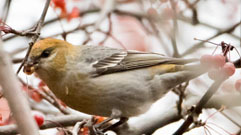 2/21 – Washington County, HRM 193: We spotted a lovely crabapple tree in Salem with five pine grosbeaks, four females, one male (Pinicola enucleator). Just a short distance away, heading west, we encountered a huge flock of snow buntings (more than 250 birds) that included a group of 30 horned larks and at least one Lapland longspur. (Photo of pine grosbeak courtesy of Sue Barth)
2/21 – Washington County, HRM 193: We spotted a lovely crabapple tree in Salem with five pine grosbeaks, four females, one male (Pinicola enucleator). Just a short distance away, heading west, we encountered a huge flock of snow buntings (more than 250 birds) that included a group of 30 horned larks and at least one Lapland longspur. (Photo of pine grosbeak courtesy of Sue Barth)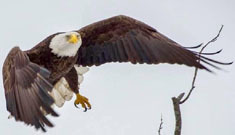 2/16 – Norrie Point, HRM 85: Twenty-five of us, with scopes and binoculars, gathered on the back deck of the Norrie Point Environmental Education Center to see what the river had to offer. The east side of the Hudson was fairly frozen over while the west side, including the channel, was a river of ice floes heading seaward. The strong ebb current had the cans, channel markers, and other aids-to-navigation leaning downriver. Our first sight was of a pair of adult bald eagles doing aerial pirouettes over Esopus Island. We wondered if these were from bald eagle nest NY142 across the river in Ulster County. Before long, one of the adults landed in NY142 and settled in what appeared to be an incubating posture. A few hours later, the second adult arrived and changed places, maintaining coverage. [Note: Dave Lindeman had witnessed this behavior in NY142 for several days.] (Photo of bald eagle courtesy of Jackie Currie)
2/16 – Norrie Point, HRM 85: Twenty-five of us, with scopes and binoculars, gathered on the back deck of the Norrie Point Environmental Education Center to see what the river had to offer. The east side of the Hudson was fairly frozen over while the west side, including the channel, was a river of ice floes heading seaward. The strong ebb current had the cans, channel markers, and other aids-to-navigation leaning downriver. Our first sight was of a pair of adult bald eagles doing aerial pirouettes over Esopus Island. We wondered if these were from bald eagle nest NY142 across the river in Ulster County. Before long, one of the adults landed in NY142 and settled in what appeared to be an incubating posture. A few hours later, the second adult arrived and changed places, maintaining coverage. [Note: Dave Lindeman had witnessed this behavior in NY142 for several days.] (Photo of bald eagle courtesy of Jackie Currie)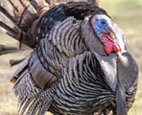 2/17 – Saratoga County, HRM 200: I checked out the Williams Lane area in Northumberland today counting 20 snow buntings, 20 horned larks, and two Lapland longspurs. Not far away, were 20 wild turkeys, their iridescent feathers showing the colors of a rainbow. (Photo of wild turkey courtesy of Debbie Quick)
2/17 – Saratoga County, HRM 200: I checked out the Williams Lane area in Northumberland today counting 20 snow buntings, 20 horned larks, and two Lapland longspurs. Not far away, were 20 wild turkeys, their iridescent feathers showing the colors of a rainbow. (Photo of wild turkey courtesy of Debbie Quick) 2/19 – Hudson Valley Estuary: This week’s fish is the summer sucker, a freshwater species number 68 (of 228) on our watershed list of fishes. The summer sucker has been known to science since at least 1866, when it was described and named by fish culturist Fred Mather (Catostomus utawana) and has certainly been in our watershed much longer. They live in small headwater lakes and streams of the Adirondack Mountains and is the only endemic (found nowhere else) species in New York State. And yet, until recently, was not on our list of watershed fishes. That omission was corrected in 2016, when it was added as species number 225.
2/19 – Hudson Valley Estuary: This week’s fish is the summer sucker, a freshwater species number 68 (of 228) on our watershed list of fishes. The summer sucker has been known to science since at least 1866, when it was described and named by fish culturist Fred Mather (Catostomus utawana) and has certainly been in our watershed much longer. They live in small headwater lakes and streams of the Adirondack Mountains and is the only endemic (found nowhere else) species in New York State. And yet, until recently, was not on our list of watershed fishes. That omission was corrected in 2016, when it was added as species number 225.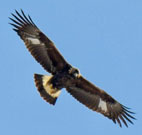 2/20 – Eastern Dutchess County, HRM 96: I put up my binoculars to watch a red-tailed hawk in flight when an immature golden eagle flew into my view. The bird was distant, but I could clearly see the diagnostic features: small head and bill, white wing patches (no white armpits), well-defined tail band, and a golden nape. (Photo of golden eagle courtesy of Deborah Tracy-Kral)
2/20 – Eastern Dutchess County, HRM 96: I put up my binoculars to watch a red-tailed hawk in flight when an immature golden eagle flew into my view. The bird was distant, but I could clearly see the diagnostic features: small head and bill, white wing patches (no white armpits), well-defined tail band, and a golden nape. (Photo of golden eagle courtesy of Deborah Tracy-Kral)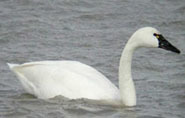 2/21 – Ulster County, HRM 90: This afternoon, Peter Schoenberger discovered an adult tundra swan with a large flock of Canada geese on Esopus Creek between Hurley and Stone Ridge. This portion of the creek flows very close to Route 209 and is often a good spot to check for early season waterfowl arrivals. Today, there were also first-of-season (FOS) American wigeons. (Photo of tundra swan courtesy of Diane McAllister)
2/21 – Ulster County, HRM 90: This afternoon, Peter Schoenberger discovered an adult tundra swan with a large flock of Canada geese on Esopus Creek between Hurley and Stone Ridge. This portion of the creek flows very close to Route 209 and is often a good spot to check for early season waterfowl arrivals. Today, there were also first-of-season (FOS) American wigeons. (Photo of tundra swan courtesy of Diane McAllister) 2/22 – Town of Fishkill, HRM 63: Just minutes after sunrise this morning, a Carolina wren appeared and picked peanuts from my cylindrical peanut feeder. Up and down and around it went picking out the peanuts giving me a long and satisfying look. (Photo of carolina wren courtesy of John Badura)
2/22 – Town of Fishkill, HRM 63: Just minutes after sunrise this morning, a Carolina wren appeared and picked peanuts from my cylindrical peanut feeder. Up and down and around it went picking out the peanuts giving me a long and satisfying look. (Photo of carolina wren courtesy of John Badura)